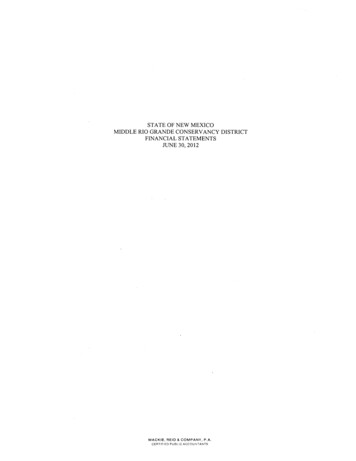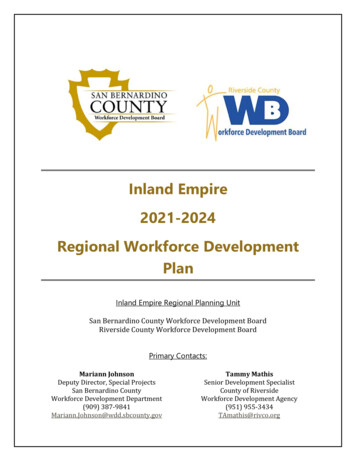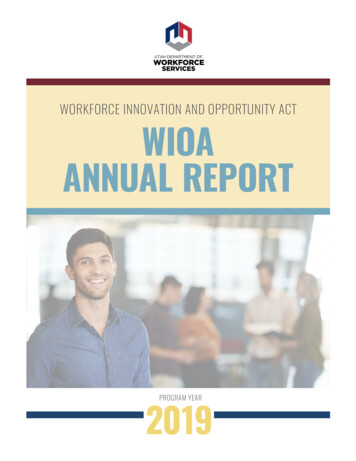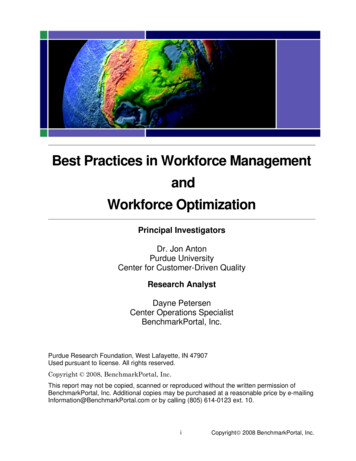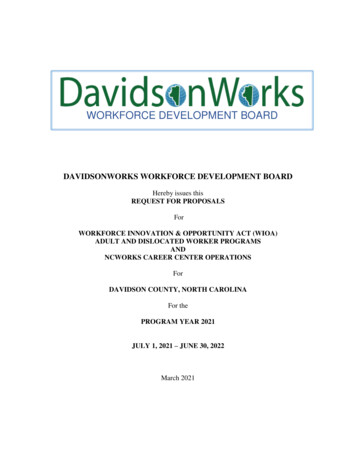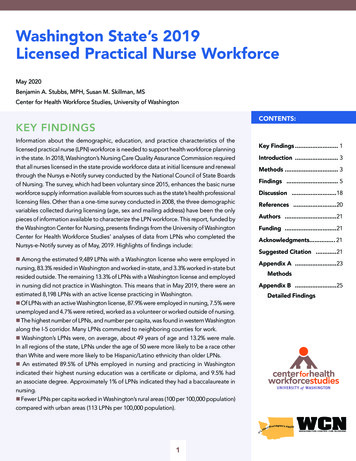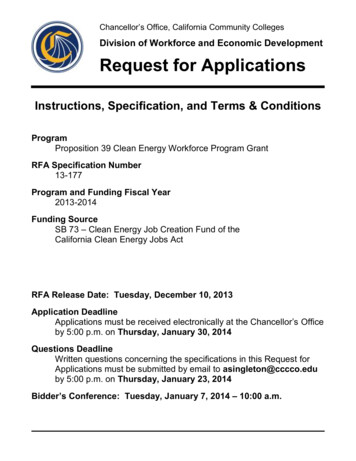
Transcription
Chancellor’s Office, California Community CollegesDivision of Workforce and Economic DevelopmentRequest for ApplicationsInstructions, Specification, and Terms & ConditionsProgramProposition 39 Clean Energy Workforce Program GrantRFA Specification Number13-177Program and Funding Fiscal Year2013-2014Funding SourceSB 73 – Clean Energy Job Creation Fund of theCalifornia Clean Energy Jobs ActRFA Release Date: Tuesday, December 10, 2013Application DeadlineApplications must be received electronically at the Chancellor’s Officeby 5:00 p.m. on Thursday, January 30, 2014Questions DeadlineWritten questions concerning the specifications in this Request forApplications must be submitted by email to asingleton@cccco.eduby 5:00 p.m. on Thursday, January 23, 2014Bidder’s Conference: Tuesday, January 7, 2014 – 10:00 a.m.
Table of ContentsThis section MUST be followed in developing the applications and implementing the projects.RFA InstructionsA.Introduction .B.Program Overview .C.Categories for Which Funding is Available .D.Eligibility.E.Performance Period .F.RFA Clarification.G.Bidder’s Conference.H.Application Format and Instructions .I.Rejection of Application .J.Calendar of Key/Reporting Dates .RFA SpecificationBackground.Need.Response to Need .Objectives/Outcomes .Project Management Plan .Reporting Requirements.Reference Materials.Terms and Conditions.Appendix AGrant AgreementArticle I: Program-Specific Legal Terms and ConditionsArticle II: Standard Legal Terms and ConditionsAppendix BApplication Forms (Excel Spreadsheet)Appendix CApplication TemplatesAppendix DGuidelines, Definitions and Allowable ExpendituresAppendix ECommon Metrics and Accountability MeasuresRFA Specification Number 13-177Page114999101017182121222223232425
Chancellor’s Office, California Community CollegesRFA InstructionsA.IntroductionThis document contains general instructions, procedures, formats, and timelines forsubmitting project applications to the Chancellor’s Office of the California CommunityColleges.Applications must be submitted using the format and sequence described in theseInstructions and address the Request for Applications (RFA) Specification for the projectfor which funding is sought.B.Program OverviewProposition 39 Clean Energy Workforce Program GrantThe California Clean Energy Jobs Act, an initiative approved by the voters asProposition 39 at the November 6, 2012, statewide general election, made changes tocorporate income taxes and provides for the transfer of 550,000,000 annually from theGeneral Fund to the Clean Energy Job Creation Fund for five (5) years beginning withthe 2013-14 fiscal year. Enacted into California law as SB 73, this legislation allocatesresources for purposes of funding eligible projects that create jobs in Californiaimproving energy efficiency and expanding clean energy generation through renewableenergy. Existing law provides for the allocation of available funds to public schoolfacilities, university and college facilities, and other public buildings and facilities, as wellas job training and workforce development and public-private partnerships for eligibleprojects associated with energy related building commissioning and recommissioning.The California Community Colleges, Chancellor’s Office is authorized to allocate 6 million during 2013-2014, of which 5 million will be towards the Proposition 39Clean Energy Workforce Program Grant and another 1 million for additional jobtraining and workforce development projects. This 2013-2014 RFA is planned as thefirst of several competitive grant opportunities spanning the full term of Proposition 39funding.ObjectivesThis Proposition 39 Clean Energy Workforce Program supports the following objectivesfor building the energy efficiency workforce: Build and sustain regional networks of colleges to prepare workforce for the energysector to improve energy efficiency and expand clean energy generation in the builtenvironment. Leverage assets at multiple colleges across a region to align and regionalize energyefficiency related curriculumRFA Specification Number 13-177 — Page 1
Assure compliance to codes and standards by upgrading workforce capacity,knowledge, and skills over the life of the Proposition 39 (SB 73) funding stream Develop sustainable partnerships and methods that link carbon reduction policy andeconomic development goals to industry needs and education and training programs Elevate the quality of instruction at colleges that have made investments ineducation and training in the energy efficiency and renewable energy sector Incentivize (through instructor stipends, etc.) regional cooperation, includingcurriculum alignment; increased access to certificates, degrees and state-certifiedapprenticeship programs; increased access to employment; and faculty professionaldevelopment Build career pathways that assure student success by connecting student learningoutcomes directly to employment opportunities Enroll all energy related pathway students in EDD’s CalJOBS system and collectoutcomes data via the Launchboard Prepare the energy efficiency workforce to participate in the construction, repair andmaintenance of commercial, industrial, and institutional buildings as required to meetAB 32 requirements Coordinate efforts with the community college Sector Navigator and Deputy SectorNavigators in the Energy Efficiency & Utilities SectorProgram Outcome MetricsMomentum Points:MP 17 Completed a non-CCCCO-approved certificate – credit based (at least 6 units)MP 18 Completed a CCCCO-Approved Certificate of AchievementMP 23 Completed an AA/AS Degree in a major aligned with student’s CTE pathwayMP 28 Job placement or apprenticeship in the same or similar field of study aseducational pathway (for students completing more than six units in a creditbased program) Student registration in CalJOBS to assist access toemployment.MP 29 Industry recognized 3rd party credentialMP 30 Wage gain in a career the same or similar to CTE educational pathwayLeading Indicators:LI 1Alignment of skillsets within a program (or set of courses) to aparticular occupation and the needs of the labor marketLI 2Regionalization of stackable certificates aligned with a particularoccupation ladderLI 3Alignment of a certificate with state-, industry-, nationally-, and/oremployer-recognized certificationRFA Specification Number 13-177 — Page 2
LI 4Creation of a credit certificate from non-credit certificateLI 5Curriculum articulation along a career or multi-career educational pathwayLI 6Updating the skills of faculty, teachers, counselors, and/or ‘supporting staff tostudents’ to reflect labor market needsAreas of emphasis will include the number of unduplicated students participating inthese programs that secure apprenticeships, complete energy related certificates, andsecure employment in energy efficiency related jobs as identified through data from theDivision of Apprenticeship Standards (DAS) and the California EmploymentDevelopment Department (EDD) job placement system (CalJobs).Target OccupationsBased on extensive labor market analysis, the RFA places a priority on occupations inthe commercial, industrial, and institutional sectors of energy efficiency and cleanenergy generation, although other occupations in these sectors may be targeted inresponse to industry needs and grant applicant documentation. See the referencesection for additional information on energy related jobs and Labor Market Information(LMI). Chancellor’s Office Taxonomy of Programs codes will be used to provideaccurate data collection on certificate completion through community collegeManagement Information System (MIS) reports.ooooooooElectriciansFirst-line Supervisors of Construction Trades and Extraction WorkersPlumbers, Pipefitters, and SteamfittersHeating, Air Conditioning and Refrigeration Mechanics and InstallersCost Estimators (particularly Commercial Energy Auditors)Construction and Building InspectorsSheet Metal WorkersStationary Engineers and Boiler OperatorsExamples of Community College Energy Related Instructional Programs Architectural Technology Apprenticeship with Journeyman Certification (in energy related crafts includingcarpentry, electricians, plumbers, and sheet metal workers) Construction Management Construction Technology Construction Inspection Energy Efficiency Electrical Systems and Power Transmission Electronics and Electric Technology Engineering Technology Environmental Control Technology (HVAC) Industrial Systems Technology & MaintenanceRFA Specification Number 13-177 — Page 3
C.Pre-Apprenticeship (requires partnership with energy related Apprenticeshipprogram(s) approved by the Division of Apprenticeship Standards)Renewable Energy including Solar TechnologyCategories for Which Funding is AvailableThe Proposition 39 Clean Energy Workforce Program provides one-time funding. Thisapplication covers the grant period beginning March 5, 2014 through March 31, 2015.The total budget for this Request for Application is 5 million.Five (5) grants will be awarded, one in each regional grouping. The regional groupingsare listed here and more specifically in the RFA Specification: North/Far North (includes Greater Sacramento, Northern Inland,Northern Coastal) Bay Area (includes San Francisco/San Mateo, East Bay, North Bay,Silicon Valley, Santa Cruz/Monterey) Central Valley, Mother Lode, South Central Los Angeles/Orange County San Diego/Imperial, Desert/Inland EmpireEach grant will be divided into two separate areas: Program Operations and ProgramImprovement. One (1) college district from within each regional grouping will be thefiscal agent and will employ the project director, who will be responsible for programoperations and distribution of program improvement funding.The application shall describe in detail how colleges within the regional network willparticipate. The funding in this RFA is for aligning and strengthening existing energyefficiency programs and not for developing new programs. It is the intent of this RFAthat a majority of colleges with existing energy efficiency programs in each region willparticipate. Colleges may only participate in one Regional Network for this grant.Colleges that are chosen as grantees are expected to partner with all energy efficiencyprograms within their regional groupings, including those which were not on the initialgrant application.Program OperationsEach grant will include 350,000 for the project director (maximum salary of 150,000including benefits) for salaries, marketing, data collection, regional meetings, travel,faculty stipends, support staff, and related costs. Project directors will be responsiblefor: Convening regional discipline committees with employers and community collegefaculty for articulation and alignment of energy efficiency related curriculum withindustry needs and industry-recognized third party credentials. Duties will includemaking arrangements for facilities, training, hotel and meeting rooms, facultystipends, and all other related costs.RFA Specification Number 13-177 — Page 4
Outreach to employers, colleges, and regional entities including high schools, localworkforce investment boards (LWIBs), the California Conservation Corps, andcolleges for recruitment of faculty, students, and employers. Recruitment of regionalemployers for registration and participation in the CalJOBS system. Payment of stipends and program improvement awards based upon verification ofrequired activities by participating community college programs and faculty.Overall program success measured by the increase of student participation incommunity college energy efficiency related instructional programs, studentcompletion of energy efficiency related programs, and enrollment in CalJOBS ofstudents completing energy related certificates. Data collection and reporting via LaunchBoard. Note: regional issues requiring external review will be mediated by the state EnergyEfficiency and Utilities Sector Navigator.Program Improvement FundingEach grant will include program improvement funding allocated on a regional populationformula. These funds will be awarded to participating energy related instructionalprograms in October 2015 2014 based upon the number of documented (unduplicated)energy related student awards including certificates with 6 to 18 units; certificatesabove 18 units; or industry recognized third party credentials. For instructionalprograms to be eligible for funding, students that complete energy related certificates orcredentials must be registered in the CalJOBS system.Allocation of program improvement funding will be based upon 2013-2014 certificatesawarded to students enrolled in participating energy related programs and listed in theChancellor's Office MIS system or documentation of third party certification provided tothe regional project director. Certificates under 18 units or third party credentials willreceive a maximum award of 500 each; and certificates or degrees above 18 units willreceive a maximum award of 1,000 each. Programs can receive only one programimprovement award per student.If allocated funding within a regional grouping is insufficient to fund all documentedenergy related awards, the amount of the awards will be reduced proportionately. Ifprogram improvement funding is not fully expended in a regional grouping after themaximum awards are allocated, the remaining funding will be returned to programoperations to support energy efficiency related instructional programs within the regionalgrouping and at the discretion of the Chancellor’s Office, may be reallocated to otherregional grouping(s).Allocated program improvement funding must be fully expended by March 31, 2015, insupport of participating programs for energy related supplies and equipment, facultyprofessional development activities, and/or curriculum or program development.Colleges that do not expend program improvement funding within the required timeframe, or that do not spend the funding appropriately, will be deemed ineligible for futureClean Energy Program Improvement Funding.RFA Specification Number 13-177 — Page 5
Data CollectionCertificate data will be submitted by colleges through the community college MISreporting system, which is aligned with Launch Board. After the end of the 2013-2014fiscal year the annual number of students participating in community college energyrelated programs will be collected.Baseline data for these programs in terms of enrollments, completers, and enrollment inthe CalJOBS system will be determined based on annual MIS data and EDD dataprovided for the 2012-2013 academic year. Maintenance of effort and increasedoutcomes will be determined on an annual basis to demonstrate: Matriculation of local residents and veterans into state-certified apprenticeshipprograms and full-time employment. The number of students from these programs, including the identification of theirlevel of preparation for employment (certificates, degrees, industry credentials) inenergy related jobs, produced statewide, regionally, and locally by CaliforniaCommunity Colleges. The number of participating students enrolled in the CalJOBS system. The number of students participating in these programs that secure apprenticeships,full-time employment and/or paid internships/trainee positions as identified throughthe Division of Apprenticeship Standards (DAS) and the California EmploymentDevelopment Department (EDD) job placement system (CalJOBS).Proposition 39 Energy Efficiency Workforce Development ProjectAllocation TableMacroRegionNumber1Funded Region BreakoutNorthern Inland, Northern Coastal,Greater Sacramento RegionsAmerican River CollegeButte CollegeCollege of the RedwoodsCollege of the SiskiyousCosumnes River CollegeFeather River CollegeFolsom Lake CollegeLake Tahoe Community CollegeLassen CollegeMendocino CollegeSacramento City CollegeShasta CollegeSierra CollegeWoodland Community CollegeMinimumnumber ofcollegesrequiredfor grantProgramOperationsFundingMaximumAmount ofProgramImprovementFunding6 350,000 330,598RFA Specification Number 13-177 — Page 6
MacroRegionNumber23Funded Region BreakoutYuba CollegeSan Francisco/San Mateo,East Bay, Silicon Valley, North Bay,Santa Cruz/Monterey RegionsBerkeley City CollegeCabrillo CollegeCañada CollegeChabot CollegeCity College of San FranciscoCollege of AlamedaCollege of MarinCollege of San MateoContra Costa CollegeDeAnza CollegeDiablo Valley CollegeEvergreen Valley CollegeFoothill CollegeGavilan CollegeHartnell CollegeLaney CollegeLas Positas CollegeLos Medanos CollegeMerritt CollegeMission CollegeMonterey Peninsula CollegeNapa Valley CollegeOhlone CollegeSanta Rosa Jr. CollegeSolano Community CollegeSan Jose City CollegeSkyline CollegeWest Valley CollegeCentral Valley, Mother Lode,South Central RegionsAllan Hancock CollegeAntelope Valley CollegeBakersfield CollegeCerro Coso Community CollegeCollege of the CanyonsCollege of the SequoiasColumbia CollegeCuesta CollegeFresno City CollegeMerced CollegeModesto Junior CollegeMoorpark CollegeOxnard CollegeMinimumnumber ofcollegesrequiredfor grantProgramOperationsFundingMaximumAmount ofProgramImprovementFunding10 350,000 741,5548 350,000 517,790RFA Specification Number 13-177 — Page 7
MacroRegionNumberFunded Region BreakoutPorterville CollegeReedley CollegeSan Joaquin Delta CollegeSanta Barbara City CollegeTaft CollegeVentura CollegeWest Hills College, CoalingaWest Hills College, LemooreMinimumnumber ofcollegesrequiredfor grantProgramOperationsFundingMaximumAmount ofProgramImprovementFunding4San Diego/Imperial, Desert/InlandEmpire RegionsBarstow Community CollegeChaffey CollegeCollege of the DesertCopper Mountain CollegeCrafton Hills CollegeCuyamaca CollegeGrossmont CollegeImperial Valley CollegeMira Costa CollegeMoreno Valley CollegeMt. San Jacinto CollegeNorco CollegePalo Verde CollegePalomar CollegeRiverside City CollegeSan Bernardino Valley CollegeSan Diego City CollegeSan Diego Mesa CollegeSan Diego Miramar CollegeSouthwestern CollegeVictor Valley College8 350,000 518,1665LA County/Orange County RegionsCerritos CollegeCitrus CollegeCoastline Community CollegeCypress CollegeEast Los Angeles CollegeEl Camino CollegeFullerton CollegeGlendale Community CollegeGolden West CollegeIrvine Valley CollegeLong Beach City CollegeLos Angeles City CollegeLos Angeles Harbor CollegeLos Angeles Mission CollegeLos Angeles Pierce College10 350,000 1,141,712RFA Specification Number 13-177 — Page 8
MacroRegionNumberD.Funded Region BreakoutLos Angeles Southwest CollegeLos Angeles Trade-Tech CollegeLos Angeles Valley CollegeMt. San Antonio CollegeOrange Coast CollegePasadena City CollegeRio Hondo CollegeSaddleback CollegeSanta Ana CollegeSanta Monica CollegeSantiago Canyon CollegeWest Los Angeles CollegeMinimumnumber ofcollegesrequiredfor grantProgramOperationsFundingMaximumAmount ofProgramImprovementFundingEligibilityOnly California Community College districts are eligible to apply as the fiscal agent. Ifan application does not meet a minimum score of 75 points deemed to meet theperformance and viability standards, it will not be funded, and the RFA can be reissuedfor competitive bid or sole sourced in the form of a capacity-building grant.The Chancellor’s Office will consider past performance of grantees prior to awardingadditional funds to those reapplying for contracts and grants, and shall denyapplications from grantees that exhibited unsatisfactory performance. Therefore pastperformance of other state grants will be a consideration prior to final selection.E.Performance PeriodThe application will be awarded for the time period of March 5, 2014 through March 31,2015. See listing of key dates on page 18 for quarterly and final report deadlines for thefirst year.No extensions will be granted for this funding.F.RFA ClarificationIf any ambiguity, conflict, discrepancy, omission, or other error in this RFA isdiscovered, immediately notify the Chancellor’s Office of the error and request a writtenmodification or clarification of the document. A clarifying addendum will be given to allparties who have obtained the RFA, without divulging the source of the request. Insofaras practical, the Chancellor’s Office will give such notice to other interested parties, butthe Chancellor’s Office shall not be responsible for failure to do so.The contact person for these Instructions and/or RFA Specification is:Abigail Singleton via e-mail at asingleton@cccco.eduRFA Specification Number 13-177 — Page 9
G.Bidder’s ConferenceA Bidder’s Conference will be held for this RFA as a Webinar. Webinars will be held atthe Chancellor’s Office on the date and time posted on the cover of this RFA. TheChancellor’s Office requests that potential applicants register for this Webinar atwww.cccconfer.org. Failure to attend the Bidder’s Conference will not preclude thesubmission of an application.H.Application Format and InstructionsAn Excel workbook (Appendix B) has been developed which contains a contact page,annual workplan, application budget summary, and an application budget detail sheet.This workbook must be used when submitting an application and has been designed inorder to save the applicant time in filling out redundant information and containsformulas that will also prevent errors in allocation amount, indirect costs, etc. Narrativesections such as the cover letter, abstract, need, response to need, the managementsection and intent-to-participate letters are not part of this workbook (an applicationchecklist, CEO cover letter template, intent-to-participate form letter template and outof-state travel form can be found in Appendix C, Application Templates). The followinginstructions prescribe the format and order for the development and presentation of theapplication (for both the Excel workbook and the narrative sections of the application).In order to receive the highest possible score and to prevent disqualification, theapplication format instructions must be followed, the application must follow the orderprescribed below, all questions must be answered, and all requested data must besupplied. Applicants are expected to follow these instructions while using the RFASpecification (page 19) and the forms and templates provided in Appendices B and C.The Chancellor’s Office may require the applicant to make adjustments in the budget,annual work plan, or other aspects of the application prior to funding the grant.Grant applications are scored based on a maximum of 100 points as indicated onsections listed below.NOTE: A minimum averaged score of 75 must be obtained within the reading processin order to be considered for funding.NeedResponse to NeedAnnual WorkplanApplication Budget Summary/Application Budget Detail SheetProject ManagementDisseminationFeasibility of the ProjectTotal PointsRFA Specification Number 13-177 — Page 10Maximum points1015251020515100
1.Face SheetNOTE: The completed application will be submitted electronically therefore noface sheet will be required. If an application is funded, an appropriate face sheetwith instructions will be sent out for completion.2.Cover LetterThe Chief Executive Officer/Designee of the applying Community College Districtwill submit a cover letter with signature within the electronic submission statingthat the Community College District is willing to be fiscal agent of a consortiumand is submitting the application for Chancellor’s Office review (see Appendix C,Application Templates for CEO cover letter template).3.Contact PageAn Excel workbook (Appendix B) contains the contact page, budget forms andannual work plan. The first tab “Do First” of the workbook requires the applicantto fill in the following information first: Region - Select the applicable region as shown in the Proposition 39 CleanEnergy Job Creation Fund Workforce Program Allocation Table (click twice inthe region text box to make the selection within the drop down menu). District – Select the Community College District that is applying (click twice inthe district text box to make the selection within the drop down menu). College - If a college within the district is housing the project director, thenselect the applicable college. If the project director is working out of thedistrict office (in a multi-college district), then select N/A. Click twice in thecollege text box to make these selections within the drop down menu.After filling in the “Do First” tab, the district and college names will auto fill to theappropriate forms. The contact page tab must be filled in second. After filling inthe contact page, both the Project Director and the District Chief BusinessOfficer’s name and title will auto fill within the application Budget Summary form.These auto fill features prevent incorrect and/or inconsistent information withinthe application.4.Application Abstract (Narrative – Limited to one page, 1” margins, single ordouble-spaced, 12 pt. Arial font)The abstract should concisely summarize the entire application and must notexceed one page. Include statements on the objectives, procedures, expectedcontribution or impact on the funding priorities of the RFA Specification, anddeliverables (products/services/outcomes).RFA Specification Number 13-177 — Page 11
5.Table of ContentsThe Table of Contents shall be on a separate page, with each component of theapplication listed and page numbers indicated.6.NeedMaximum Points 10(Narrative – Limited to 5 pages, 1” margins, single or double-spaced,12 pt. Arial font)The purpose of the need section is so that the applicant can concisely describethe regional landscape as it currently exists as it relates to energy sector trainingand workforce needs.7.Response to NeedMaximum Points 15(Narrative – Limited to 7 pages, 1” margins, single or double-spaced,12 pt. Arial font)The response to the needs section responds to the objectives and identifies whowill be a part of developing a regional plan; how regions will meet the trainingneeds of students and industry; and how each region prepare employees for theenergy sector at the participating colleges.8.Annual WorkplanMaximum Points 25The annual workplan is found in Appendix B, Application Forms. As a courtesy,5 tabs have been provided within the Excel workbook numbered AnnualWorkplan-1 to 5 as templates for up to the first five objectives. If you needadditional pages for a single objective, the Excel workbook allows you to makemore copies of any Annual Workplan tab.a.ObjectivesObjectives should be based on the scope of the proposed project whileremaining consistent with the Objectives of the RFA Specification.List one objective per form, along with corresponding measurableoutcomes, activities, timelines, and responsible individual. Label theobjectives in sequential order: Objective #1.0 at the top of page one;Objective #2.0 at the top of page two, and so forth.Additional copies of the form will be needed to address all of the projectobjectives.NOTE: While each objective must be on its own form that does notpreclude a single objective having activities that cover more than onepage.RFA Specification Number 13-177 — Page 12
b.Procedures/ActivitiesProject activities are the basic steps that need to be taken to implementthe project and to achieve results. Major activities and tasks should beoutlined in the activities section of the annual workplan for each objective.c.TimelinesProvide the projected completion date for key activities within the term ofthe grant. Identify the month and year in which activities will be completed.NOTE: As closely as possible, determine starting and ending month ofeach activity. It is not acceptable to make all activities year long or tostate “ongoing.”d.Responsible PersonsIdentify, by position, individual(s) responsible for completing activities.e.Performance OutcomesEach objective should result in measurable outcomes that clearly link tothe objectives and activities. Describe the outcomes in qualitative andquantitative terms. Address any performance outcomes unique to thisproject that will result from the implementation of the objectives andactivities listed in the Annual Workplan.f.Metric Number(s)Identify which of the CCCCO-provided Common Metrics & AccountabilityMeasur
Pre-Apprenticeship (requires partnership with energy related Apprenticeship program(s) approved by the Division of Apprenticeship Standards) Renewable Energy including Solar Technology C. Categories for Which Funding is Available . The Proposition 39 Clean Energy Workforce Program provides one-time funding. This
